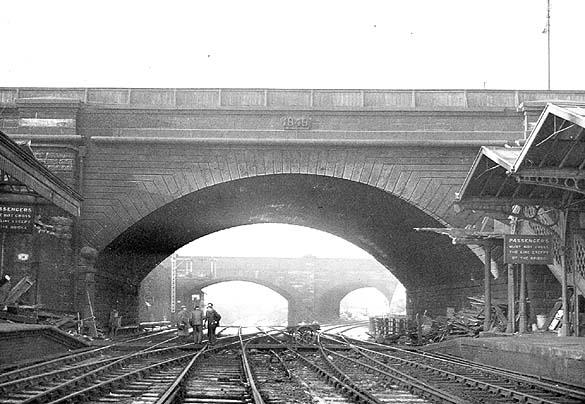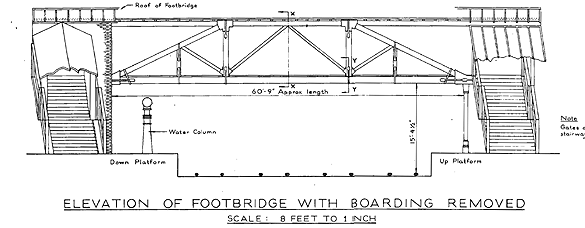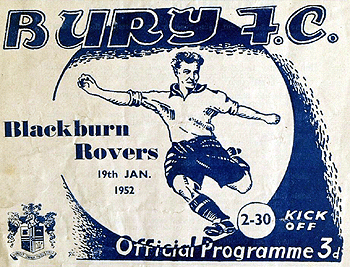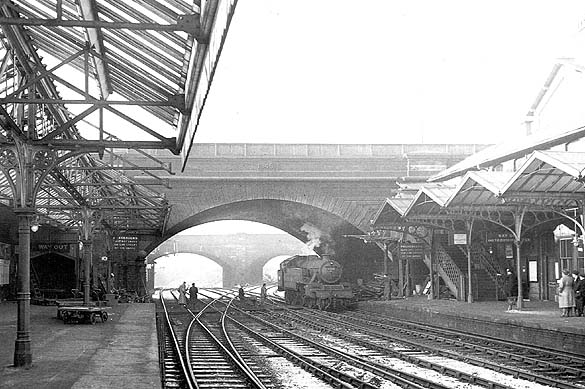
BURY KNOWSLEY STREET
|
Sometime around 1881 the Lancashire & Yorkshire Railway (LYR) built a footbridge at Bury Knowsley Street. It was located at the western end of the station immediately to the east of the sandstone arch bridge that carried Knowsley Street over the Bolton – Castleton line. The footbridge, officially Bridge No.18, was 72ft 6in long with a clear span of 60ft 9in. It extended from a retaining wall that supported the up side booking office to a brick abutment on the down side. The main structure consisted of two timber queen post trusses which carried a 4in-thick timber floor. The trusses rested on iron columns on the up platform and on the brick abutment on the down side.
The length of the trusses was 64ft 9in spaced at approximately 8ft 7in centres. They were made up from 14in by 7in timber bottom booms and 12in by 7in top booms, queen posts and raking struts. Cross members and minor verticals were 7in by 6in. The flooring was carried on the bottom boom. As this put tension on the queen posts wrought iron straps were used to transfer the load. They were 3¼in wide by ⅜ in thick. Each strap passed around the bottom boom and was held to the queen posts by an unusual fastening consisting of a key and two cotters. The minor verticals were secured by similar but smaller iron straps. The footbridge was provided with a roof and it was boarded on the sides to protect passengers from the weather. Boarding of the bridge in this way partly obscured the wrought iron straps and the timber booms. This made it difficult to inspect. Inspections were carried out over the years and some ironwork was replaced. Bridge No.18 became part of British Railways (BR) London Midland Region (LMR) on 1 January 1948. By that time the original drawings for the bridge had been lost. BR(LMR) carried out an inspection of the bridge 6 May 1948. No serious flaws were uncovered during that inspection but it was recommended that all outside boarding be replaced. The bridge was painted in 1949.
Many away supporters travelled to the match and special trains were laid on for them. Blackburn Rovers won the game by two goals to nil and approximately 3,200 of their jubilant supporters walked to Bury Knowsley Street station to catch a train home. Four special trains had been laid on by BR(LMR) to carry an estimated 3,000 people. They were timed to depart at 4.35pm, 4.40pm, 4.44pm and 4.46pm and they were all scheduled to depart from the down platform. In addition there were fans who intended to travel to their homes by ordinary up direction services. This situation was not an uncommon occurrence at Bury Knowsley Street and the staff were experienced in dealing with large numbers of people. The stationmaster on duty that day was Mr G U Gray. He decided to regulate the number of passengers going onto the down platform by closing the gates at the bottom of the footbridge steps. Mr Gray did not want large numbers to build up on the platform for safety reasons and so that the special trains could be dispatched in an orderly way. For the 4.35pm train 750 passengers were allowed onto the platform before the gates were shut. A queue quickly built up that stretched up the steps, then continued over the bridge and all the way through the station and out onto Knowsley Street. The 4.35pm train departed three minutes late at 4.38pm. The footbridge gates on the down side were opened and the queue began to move in an orderly way onto the platform. At that time Mr Gray was standing on the down platform 80yd east of the bridge. He suddenly heard a creaking noise from bridge No.18 and turned around to see the bottom booms falling. The bridge had given way and approximately 200 people fell 15½ft onto the railway tracks. Sadly two people were killed. At that moment the 4.40pm train was approaching and Mr Gray turned and ran towards it, his intention being to stop it before it ran into the collapsed bridge and the passengers who had fallen with it. Leading porter D Foulkes was at that moment standing on the up platform. He ran into the foreman’s office and telephoned the signalmen to block all lines. Signalman W Abbott was on duty at Bury West Junction box and he saw the collapse. He quickly sent the ‘obstruction danger’ signal. It was received by the signalman at Bury East Junction box just in time for him to alert the guard of the 4.40pm train who applied the emergency brake and the train was stopped just short of the down platform. The prompt action of these professional railwaymen saved an even worse tragedy from occurring. Standing in the queue on the up side of the line was a BR employee, Mr R Grunshaw, a clerk with the Signals & Telecommunications Department who was off duty and had attended the match. Like the others in the queue he was making his way home. As he was about to step onto the footbridge he saw it give way. He linked arms with a number of others and through their exertions they were able to hold the crowd back from the chasm that had opened up. Had they not acted so quickly more people would have fallen onto the line below. Mr F Haythornthwaite, a resident of Blackburn, was one of the people on the bridge when it collapsed. He was in a queue about six people wide. He described the situation as being ‘tightly packed’. When the gates opened there was a cheer and the queue started to thin out; there was no stamping or running. When about a quarter of the way across Mr Haythornthwaite felt the bridge collapse. It fell about one foot at the down platform end, steadied for a second and then ‘went down just like a lift’. Grunshaw was a trained first aider and as soon as he was sure that the crowds had been held back from the fallen bridge he ran down the steps to the up platform and jumped onto the track. There he gave assistance to the injured. As soon as stationmaster Gray was satisfied that the 4.40pm train had been stopped he ran back towards the scene. He met Foulkes and telephone calls were made to the police, the fire and the ambulance services. First aid equipment was gathered from the station and the signal boxes, and all members of the station staff set to helping the injured passengers and controlling the others. The police, fire and ambulance services were on the scene within minutes. There were 173 injured people and 136 of them were conveyed to Bury General hospital, 43 being detained there. The last casualty had been removed from the scene by 6.15pm. The behaviour of the railway staff, the emergency services and the General Hospital was described as being exemplary. The stranded passengers who had been unable to board their trains were directed to Bury Bolton Street where two trains were laid on; they departed at 6.17pm and 6.50pm. The debris from the bridge had blocked all four of the running lines through Bury Knowsley Street. It was cleared away very quickly and the line reopened at 6.30pm. The line was closed again at 12.40am on 20 January so that some unsafe sections of the bridge that had not fallen could be removed. The work took until 11.05am that day, when the line reopened. The debris and broken timbers from the bridge were stacked on either side of the line underneath the Knowsley Street Bridge. Normal operations resumed at Bury Knowsley Street. Passengers wishing to cross the line had to do so via the Knowsley Street bridge (there was a sloping path that connected the down platform to the street) which was a great inconvenience. The Ministry of Transport appointed Brigadier C A Langley to investigate the matter on 22 January 1952. He carried out a thorough investigation into the collapse. As no drawings could be found the Brigadier had new ones drawn from measurements taken of the fallen timbers. The broken timbers were studied as were the wrought iron straps. The inspection regime for the bridge was also examined. Inspections had been made on 11 August 1944, 19 August 1944 and 6 May 1948. There had also been an inspection in 1946 but no records seem to have been made. Furthermore, the bridge was painted in 1949. Not one of the inspectors had made any comment about any rot to beams or corrosion of wrought iron straps. The need to replace outside boards, gutters and roofing had been highlighted.
Brigadier Langley published his report on 2 July 1952. His conclusion was that there was nothing wrong with the bridge design and it was certainly capable of carrying many hundreds of passengers at one time. The bridge had collapsed because the wrought iron straps had corroded and they were no longer spreading the load onto the supporting beams of the trusses. All of the weight of the passengers crossing the bridge on 19 January 1952 had been borne by the bottom beams and they were rotten within the brickwork on which they rested. These factors caused the bridge to collapse. In the opinion of Brigadier Langley the collapse of the bridge could have happened sooner; it was only the timberwork of the side walls that had held it up. In his report the Brigadier was critical of the engineer’s inspections that had been carried out in the 1940s. They had not followed the prescribed procedures and the serious flaws had been missed. Procedures had been tightened up in 1951 and specially trained bridge examiners had been appointed. Unfortunately the examiner who was given responsibility for the area, including Bury Knowsley Street, only took up his duties when the bridge collapsed; he had not had time to inspect it. The report praised the actions of the railway employees who had been on duty at the time of the collapse and made it clear that no blame should be attached to any of them. A replacement bridge was erected in the early months of 1953. It was demolished in the spring of 1971. Click here to return to main page
|
| Last updated: Monday, 25-Sep-2017 20:45:21 CEST |
© 2004-2017 Disused Stations
|


 On Saturday 19 January 1952 a football match took place in Bury between Bury and Blackburn Rovers. The game was a 2.30pm kick off, either to deter drunkenness or just to make use of the short daylight at that time of year. It was a Second Division match and finished 2-0 to the visitors, Blackburn. It was played at Gigg Lane, Bury in front of 25,577 spectators – a huge crowd by modern standards, but quite normal during the post-war football boom.
On Saturday 19 January 1952 a football match took place in Bury between Bury and Blackburn Rovers. The game was a 2.30pm kick off, either to deter drunkenness or just to make use of the short daylight at that time of year. It was a Second Division match and finished 2-0 to the visitors, Blackburn. It was played at Gigg Lane, Bury in front of 25,577 spectators – a huge crowd by modern standards, but quite normal during the post-war football boom. 


 Home Page
Home Page